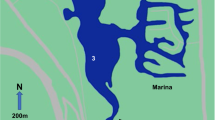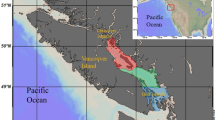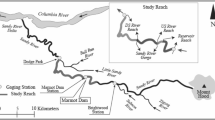Abstract
Marine fish that migrate to freshwater rivers to spawn deliver substantial quantities of marine-derived nutrients to terrestrial and freshwater environments1,2. These nutrients support riparian vegetation3, terrestrial organisms4, benthic macroinvertebrates5, algae6 and other fish populations1. Although it is known that the quantity of nutrients delivered to these environments is influenced by the number of spawning salmon7, little is known about the mechanisms of nutrient delivery. Here, we present a pathway for nutrient delivery and retention in a Pacific salmon stream, which depends on the aggregation of inorganic and organic particulate matter8. We verify the existence of this pathway in the controlled environment conditions of a recirculating flume, replicating the hydrologic conditions of a stream environment. We show that the addition of salmon organic matter and clay to the flume increases the formation of organic–inorganic aggregates in the water column, and the transfer of these aggregates to the stream bed. We find that the formation of these aggregates is associated with an increase in the concentration of bacteria in the stream bed. We suggest that bacterial aggregation of salmon organic matter and inorganic particulate matter delivers nutrients to streambeds, and thus plays an integral role in nutrient cycling in Pacific salmon streams.
This is a preview of subscription content, access via your institution
Access options
Subscribe to this journal
Receive 12 print issues and online access
$259.00 per year
only $21.58 per issue
Buy this article
- Purchase on Springer Link
- Instant access to full article PDF
Prices may be subject to local taxes which are calculated during checkout




Similar content being viewed by others
References
Naiman, R. J., Bilby, R. E., Schindler, D. E. & Helfield, J. M. Pacific salmon, nutrients, and the dynamics of freshwater and riparian ecosystems. Ecosystems 5, 399–417 (2002).
Quinn, T. P. The Behaviour and Ecology of Pacific Salmon & Trout Ch. 7 (Univ. Washington Press, 2005).
Drake, D. C., Naiman, R. J. & Bechtold, J. S. Fate of nitrogen in riparian forest soils and trees: An 15N tracer study simulating salmon decay. Ecology 87, 1256–1266 (2006).
Hocking, M. D. & Reimchen, T. E. Consumption and distribution of salmon (Oncorhynchus spp.) nutrients and energy by terrestrial flies. Can. J. Fish. Aquat. Sci. 63, 2076–2086 (2006).
Chaloner, D. T., Martin, K. M., Wipfli, M. S., Ostrom, P. H. & Lamberti, G. A. Marine carbon and nitrogen in southeastern Alaska stream food webs: Evidence from artificial and natural streams. Can. J. Fish. Aquat. Sci. 59, 1257–1265 (2002).
Johnston, N. T., MacIsaac, E. A., Tschaplinski, P. T. & Hall, K. J. Effects of the abundance of spawning sockeye salmon (Oncorhynchus nerka) on nutrients and algal biomass in forested streams. Can. J. Fish. Aquat. Sci. 61, 384–403 (2004).
Scheurell, M. D., Levin, P. S., Zabel, R. W., Williams, J. G. & Sanderson, B. L. A new perspective on the importance of marine derived nutrients to threatened stocks of Pacific salmon (Oncorhynchus spp.). Can. J. Fish. Aquat. Sci. 62, 961–964 (2005).
Droppo, I. G., Leppard, G. G., Flannagan, D. T. & Liss, S. N. The freshwater floc: A functional relationship of water and organic and inorganic constituents affecting suspended sediment properties. Wat. Air Soil Pollut. 99, 43–54 (1997).
Hassan, M. A. et al. Salmon-driven bed load transport and bed morphology in mountain streams. Geophys. Res. Lett. 35, L04405 (2008).
Kondolf, G. M. Assessing salmonid spawning gravel quality. Trans. Am. Fisheries Soc. 129, 262–281 (2000).
Petticrew, E. L. in Soil Erosion and Sediment Redistribution in River Catchments: Measurement, Modelling and Management (eds Owens, P. N. & Collins, A. J.) 112–127 (CABI Publishers, 2006).
Battin, T. J., Kaplan, L. A., Newbold, J. D. & Hansen, C. M. E. Contribution of microbial biofilms to ecosystem processes in stream microcosms. Nature 426, 439–441 (2003).
Wotton, R. S. Do benthic biologists pay enough attention to aggregates formed in the water column of streams and rivers? J. North Am. Benthol. Soc. 26, 1–11 (2007).
Droppo, I. G. Structural controls on floc strength and transport. Can. J. Civ. Eng. 31, 569–578 (2004).
McConnachie, J. L. & Petticrew, E. L. Tracing organic matter sources in riverine suspended sediment: Implications for fine sediment transfers. Geomorphology 79, 13–26 (2006).
Petticrew, E. L. & Arocena, J. M. Organic matter composition of gravel-stored sediments from salmon-bearing streams. Hydrobiologia 494, 17–24 (2003).
Petticrew, E. L. in Flocculation in Natural and Engineered Environmental Systems (eds Droppo, I. G., Leppard, G. G., Liss, S. N. & Milligan, T. G.) 71–94 (CRC Press, 2004).
Battin, T. J. et al. Biophysical controls on organic carbon fluxes in fluvial networks. Nature Geosci. 1, 95–100 (2008).
Kohler, A. E., Rugenski, A. & Taki, D. Stream food web response to salmon carcass analogue addition in two central Idaho, USA streams. Freshwat. Biol. 53, 446–460 (2008).
Chaloner, D. T. et al. Variation in responses to spawning Pacific salmon among three south-eastern Alaska streams. Freshwat. Biol. 49, 587–599 (2004).
Chapman, D. W. Critical review of variables used to define effects of fines in redds of large salmonids. Trans. Am. Fish. Soc. 117, 1–21 (1988).
Petticrew, E. L. & Rex, J. F. in Sediment Dynamics and the Hydromorphology of Fluvial Systems 306 (eds Rowan, J. S., Duck, R. W. & Werritty, A) 434–411 (IAHS Press, 2006).
Williams, N. D., Walling, D. E. & Leeks, G. J. L. High temporal resolution in situ measurement of the effective particle size characteristics of fluvial suspended sediment. Wat. Res. 41, 1081–1093 (2007).
Agrawal, Y. C. & Pottsmith, H. C. Instruments for particle size and settling velocity observations in sediment transport. Mar. Geol. 168, 89–114 (2000).
Lisle, T. E. & Eads, R. E. Methods to Measure Sedimentation of Spawning Gravels. Research Note PSW-411 (USDA Forest Service, 1991).
Rex, J. F. Development of a Sediment Monitoring Protocol. MSc Thesis, Univ. of Northern British Columbia (2002).
Droppo, I. G., Jeffries, D., Jaskot, C. & Backus, S. The prevalence of freshwater flocculation in cold regions: A case study from the Mackenzie River delta, Northwest Territories, Canada. Arctic 51, 155–164 (1998).
Chikaraishi, Y., Yarada, Y. & Naoka, H. Carbon and hydrogen isotopic composition of sterols from riverine and sediments. Limnol. Oceanogr. 50, 1763–1770 (2005).
Sokal, R. R. & Rohlf, F. J. Biometry 3rd edn (W H Freeman & Company, 1995).
Acknowledgements
We thank R. Holmes, B. Best and R. Rujanschi for construction of channels at the QRRC; N. D. Williams for his work with the flumes and the LISST-ST and J. Arocena, K. Hall, S. Macdonald and M. Shrimpton for comments on this project, as well as P. N. Owens for his review of the manuscript. Funding for the project was provided by a Natural Science and Engineering Research Council grant to E.L.P. This is Contribution 3 in the Quesnel River Research Center Publication Series.
Author information
Authors and Affiliations
Contributions
This work represents the PhD focus of J.F.R. with the supervision and assistance of E.L.P. Conceptual planning of the experiment derives from earlier work by E.L.P. and J.F.R. in O’Ne-eil Creek. The manuscript was written by J.F.R. and revised and edited by both authors.
Corresponding author
Rights and permissions
About this article
Cite this article
Rex, J., Petticrew, E. Delivery of marine-derived nutrients to streambeds by Pacific salmon. Nature Geosci 1, 840–843 (2008). https://doi.org/10.1038/ngeo364
Received:
Accepted:
Published:
Issue Date:
DOI: https://doi.org/10.1038/ngeo364
This article is cited by
-
The seasonal movement of sediment-associated marine-derived nutrients in a morphologically diverse riverbed: the influence of salmon in an Interior British Columbia river
Journal of Soils and Sediments (2023)
-
Soil erosion and sediment dynamics in the Anthropocene: a review of human impacts during a period of rapid global environmental change
Journal of Soils and Sediments (2020)
-
Riparian vegetation subsidizes sea lamprey ammocoetes in a nursery area
Aquatic Sciences (2019)
-
A Critical Assessment of the Ecological Assumptions Underpinning Compensatory Mitigation of Salmon-Derived Nutrients
Environmental Management (2015)
-
The role of gravel channel beds on the particle size and organic matter selectivity of transported fine-grained sediment: implications for sediment fingerprinting and biogeochemical flux research
Journal of Soils and Sediments (2015)



